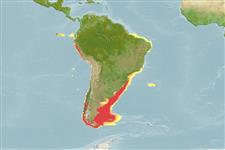Common names from other countries
Environment: milieu / climate zone / depth range / distribution range
Ekologi
Batidemersal. Subtropical; 0°N - 90°S, 180°W - 180°E
Eastern Pacific and Southwest Atlantic: Arctocephalus australis gracilis: Peru, southern Brazil, Uruguay, Argentina, Chile (Ref. 1394, 1522); vagrant to Colombia and Juan Fernandez Islands (Ref. 1522); Arctocephalus australis australis: Falkland Islands (Ref. 1522). Tropical to temperate climates.
Length at first maturity / Size / Weight / umur
Maturity: Lm ? range ? - ? cm Max length : 190 cm TL jantan/; (Ref. 1394); 140 cm TL (female); Berat maksimum terpublikasi: 200.0 kg (Ref. 1394); Berat maksimum terpublikasi: 200.0 kg
Inhabits primarily coastal, continental shelf and slope waters; and there are records from more than 600 km offshore. Feeds on small schooling fish and invertebrates such as cephalopods, crustaceans and gastropods. Found primarily coastal, continental shelf and slope waters; there are records from more than 600 km offshore. Feeds on small schooling fish and invertebrates such as cephalopods, crustaceans and gastropods (Ref. 1394).
Life cycle and mating behavior
Kematangan | Reproduksi, perkembang biakan | Pemijahan | telur-telur | Fecundity | Larva
Pups are born in dense breeding colonies. Perinatal attendance averages one week, then mothers forage offshore several days at a time. Upon arrival from sea, mother and pup reunites using vocalization signals and olfactory cues, i.e., naso-nasal contact. Lactation lasts at least 12 months.
rujukan utama
Acuan | Koordinator | mitra
Jefferson, T.A., S. Leatherwood and M.A. Webber. 1993. (Ref. 1394)
Status IUCN Red List (Ref. 130435)
status CITES (Ref. 108899)
penggunaan manusia
Perikanan: komersial
FAO - Perikanan: landings, profail spesis | FishSource | Sea Around Us
Alat, peralatan
Sumber internet
Estimates based on models
Preferred temperature
(Ref.
115969): 5.6 - 15.5, mean 9.2 (based on 1202 cells).
Daya lenting
sedang, Waktu penggandaan populasi minimum 1.4 - 4.4 tahun (K=0.3).
keancaman
Moderate to high vulnerability (52 of 100).
kategori harga
Unknown.
